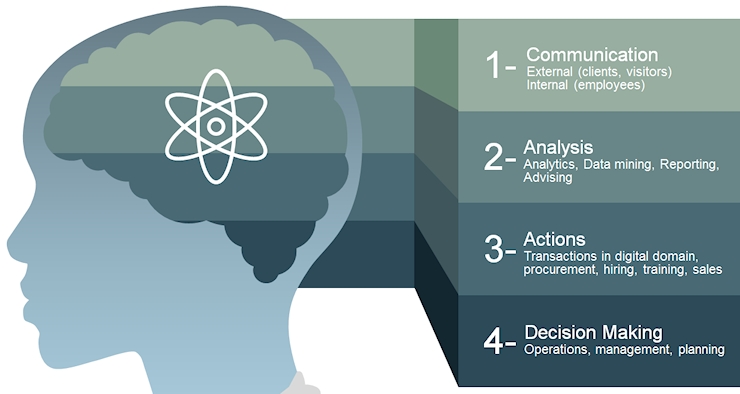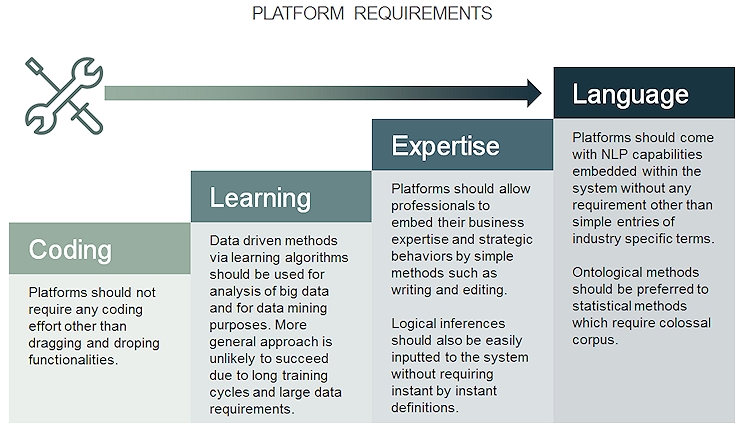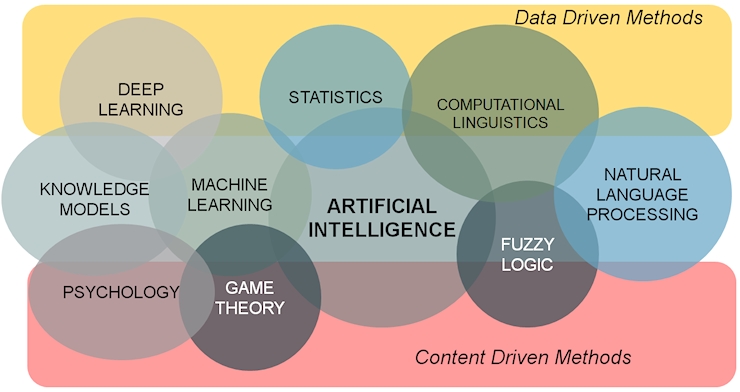All the technical jargon you have been hearing nowadays such as deep learning, artificial intelligence, natural language processing, etc., all converge to one single question for businesses: Can we build digital employees?
One may wonder what makes a digital employee different than all the software tools we are already using today. A digital employee may be defined as a computerized system that has superb communication skills using natural languages, and has some level of autonomy to make its own judgement and decisions.
Digital Employee represents the fine line where we delegate business responsibilities to autonomous systems, and where we communicate with them like talking to human employees.
WHAT WILL DIGITAL EMPLOYEES CONTRIBUTE TO?
Digital employees will directly contribute to business efficiency in 4 major areas as shown below. The communication at the top is essential for all other functions to perform cohesively. In other words, a digital employee starts from the core capability of communication and performing a high level dialogue.
HOW DO WE BUILD THEM?
Creation of a digital employee cannot be a scientific project. Otherwise, it will remain very limited to a few examples based on substantial R&D budgets. This revolution will only happen when we have platforms that allow the creation of digital employees easily and fast. Here are the some of the top requirements for such transition:
It is also important to mention that seamless integration to all communication platforms and operating systems is another key requirement.
SCIENTIFIC DISCIPLINES MUST COME TOGETHER
Creating digital employees through a platform will require many scientific disciplines and methods to amalgamate. There is no “silver bullet” solution to create such a complicated system. Below is a simplified landscape of disciplines that are most likely to contribute at least one aspect of development.
The success will depend on who has the best cocktail of methods tucked under the platform which are literally invisible to the end user (i.e., the creator of digital employees).
BUSINESS INCENTIVES
Undoubtedly, there are several benefits of gaining digital employees as outlined below. However, their limitations compared to human employees (in certain aspects) represent a tradeoff. This trade off will exist until the technology reaches human level cognition, which may take a very long time.
REVOLUTION TIMELINE
Estimating the timeline of the transformation from human information workers to digital employees is not an easy guess. Many businesses have adopted the IKEA model of DIY software during the last few decades, delegating tasks to clients. Banking is a prime example where you are supposed to use software to do transactions on your own. However, the current trend shows demand for command driven banking using conversational interfaces for requests like “Transfer $5,000 from checking to saving by tomorrow morning.” If we can talk to a digital employee, why bother using a software. And that’s the underlying promise for the upcoming revolution.
DIY Software model is wearing off, creating a future demand for digital employees.
We predict that the first solid evidence of this revolution will show itself by the fading away of DIY systems from our lives (including IKEA).





